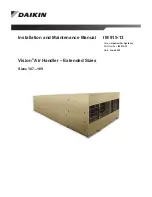
2
English
CONTENTS
1.
SAFETY INSTRUCTIONS ................................................... 2
2.
BEFORE OPERATION ........................................................4
3.
OPERATION RANGE .......................................................... 5
4.
INSTALLATION SITE .......................................................... 5
5.
LABELS AND CORRESPONDING FUNCTIONS OF THE
REMOTE CONTROLLER ................................................... 6
6. OPERATION PROCEDURE ................................................ 6
7.
OPTIMUM OPERATION ...................................................... 9
8.
MAINTENANCE (FOR SERVICE PERSONNEL) ............... 9
9.
MALFUNCTIONS NOT RELATED TO HEAT PUMP ........ 11
10. TROUBLESHOOTING ......................................................12
11. AIR HANDLER HOMEOWNER’S ROUTINE
MAINTENANCE RECOMMENDATIONS ..........................16
1. SAFETY INSTRUCTIONS
Read these “SAFETY INSTRUCTIONS for Installation”
carefully before installing an air conditioner or heat pump.
After completing the installation, make sure that the unit
operates properly during the startup operation.
Instruct the customer on how to operate and maintain the
unit. Inform customers that they should store this Installation
Manual with the Operation Manual for future reference.
Always use a licensed installer or contractor to install this
product. Improper installation can result in water or refrigerant
leakage, electrical shock, fire, or explosion.
This air conditioner comes under the term “appliances
not accessible to the general public.”
Meanings of
DANGER
,
WARNING
,
CAUTION
and
NOTE
Symbols:
DANGER
............... Indicates an imminently hazardous
situation which, if not avoided, will
result in death or serious injury.
WARNING
............. Indicates a potentially hazardous
situation which, if not avoided, could
result in death or serious injury.
CAUTION
.............. Indicates a potentially hazardous
situation which, if not avoided, may
result in minor or moderate injury. It
may also be used to alert against
unsafe practices.
NOTE
.................... Indicates situations that may result in
equipment or property-damage
accidents only.
•
Refrigerant gas is heavier than air and replaces oxygen.
A massive leak can lead to oxygen depletion, especially
in basements, and an asphyxiation hazard could occur
leading to serious injury or death.
•
Do not ground units to water pipes, gas pipes, telephone
wires, or lightning rods as incomplete grounding can
cause a severe shock hazard resulting in severe injury
or death. Additionally, grounding to gas pipes could
cause a gas leak and potential explosion causing severe
injury or death.
•
If refrigerant gas leaks during installation, ventilate the
area immediately. Refrigerant gas may produce toxic gas
if it comes in contact with fire. Exposure to this gas could
cause severe injury or death.
•
After completing the installation work, check that the
refrigerant gas does not leak throughout the system.
•
Do not install unit in an area where flammable materials
are present due to risk of explosions that can cause
serious injury or death.
•
Safely dispose all packing and transportation materials
in accordance with federal/state/local laws or
ordinances. Packing materials such as nails and other
metal or wood parts, including plastic packing materials
used for transportation may cause injuries or death by
suffocation.
•
All phases of the field-installation, including, but not
limited to, electrical, piping, safety, etc. must be in
accordance with manufacturer’s instructions and must
comply with national, state, provincial and local codes.
•
Only qualified personnel must carry out the installation
work. Installation must be done in accordance with this
installation manual. Improper installation may result in
water leakage, electric shock, or fire.
•
When installing the unit in a small room, take measures
to keep the refrigerant concentration from exceeding
allowable safety limits. Excessive refrigerant leaks, in
the event of an accident in a closed ambient space, can
lead to oxygen deficiency.
•
Use only specified accessories and parts for installation
work. Failure to use specified parts may result in water
leakage, electric shocks, fire, or the unit falling.
•
Install the air conditioner or heat pump on a foundation
strong enough that it can withstand the weight of the
unit. A foundation of insufficient strength may result in
the unit falling and causing injuries.
•
Take into account strong winds, typhoons, or
earthquakes when installing. Improper installation may
result in the unit falling and causing accidents.
Installation manual
SPLIT SYSTEM HEAT PUMP


























